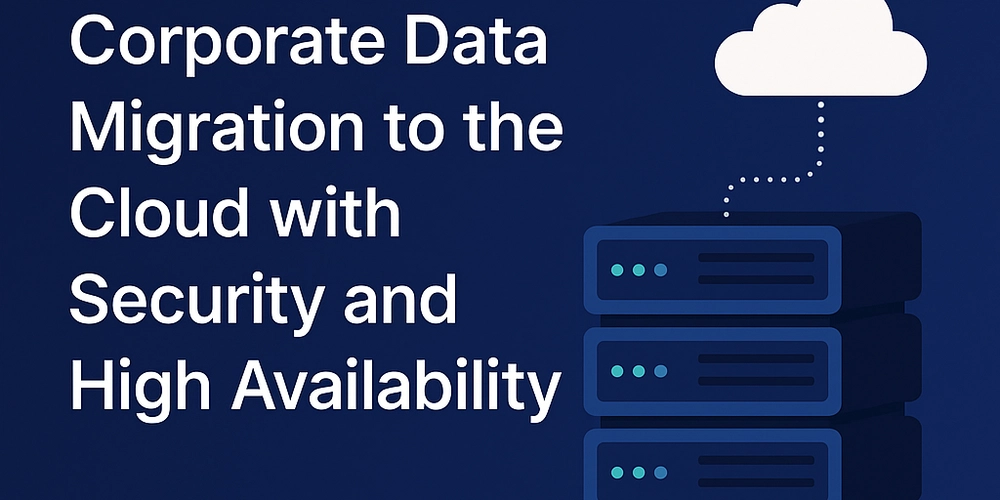How to Plan a Corporate Data Migration to the Cloud with Security and High Availability
A practical and strategic guide to cloud data migration with an emphasis on infrastructure resilience, cybersecurity, and business continuity. How to Plan a Corporate Data Migration to the Cloud with Security and High Availability Migrating corporate data to the cloud is no longer a matter of if, but when—and how well. In this article, I share key practices for planning secure, resilient, and efficient cloud data migrations, based on my 16+ years of experience in IT infrastructure, including leading strategic cloud projects at major technology companies in Brazil. Define your business and technical goals A successful migration starts with understanding what the business expects: agility, cost reduction, scalability, or resilience? From there, define: Which workloads are mission-critical Downtime tolerance Compliance requirements These definitions shape your architecture and provider choices. Assess and classify the existing environment Mapping your current environment is crucial. Create an inventory of: Applications and databases Interdependencies between systems Data volume and sensitivity Use this mapping to define the best migration strategy for each workload (lift-and-shift, replatform, or refactor). Choose the right cloud architecture Opt for a hybrid or multi-cloud model when needed. Evaluate: Latency and regional availability Built-in redundancy and failover mechanisms Service Level Agreements (SLAs) High availability requires careful selection of zones, regions, and replication methods. Plan for security and compliance Security must be a priority from day one. Adopt: Data encryption at rest and in transit Role-based access control (RBAC) Audit and monitoring tools Ensure the environment complies with regulations (e.g., LGPD, GDPR, HIPAA, etc.). Test, migrate, and validate Use pilot environments and migration waves. Key best practices include: Running stress and rollback tests Monitoring resource consumption Validating performance and data integrity after cutover I’ve led projects where this structured approach avoided critical failures in systems with over 99.9% availability requirements. Optimize and monitor post-migration Cloud migration doesn’t end with the cutover. Post-migration actions include: Cost optimization with auto-scaling and reserved instances Real-time monitoring and proactive incident response Continuous security posture improvement Final Thoughts Migrating to the cloud with security and high availability is a strategic move that demands careful planning and execution. As a professional who has led critical infrastructure transitions for major organizations in Brazil, I’ve seen the impact of well-designed cloud solutions on business resilience and innovation. This article is part of my technical contributions as an IT Infrastructure and Cloud specialist, reflecting practical insights relevant to global tech standards.

A practical and strategic guide to cloud data migration with an emphasis on infrastructure resilience, cybersecurity, and business continuity.
How to Plan a Corporate Data Migration to the Cloud with Security and High Availability
Migrating corporate data to the cloud is no longer a matter of if, but when—and how well. In this article, I share key practices for planning secure, resilient, and efficient cloud data migrations, based on my 16+ years of experience in IT infrastructure, including leading strategic cloud projects at major technology companies in Brazil.
- Define your business and technical goals A successful migration starts with understanding what the business expects: agility, cost reduction, scalability, or resilience? From there, define:
Which workloads are mission-critical
Downtime tolerance
Compliance requirements
These definitions shape your architecture and provider choices.
- Assess and classify the existing environment Mapping your current environment is crucial. Create an inventory of:
Applications and databases
Interdependencies between systems
Data volume and sensitivity
Use this mapping to define the best migration strategy for each workload (lift-and-shift, replatform, or refactor).
- Choose the right cloud architecture Opt for a hybrid or multi-cloud model when needed. Evaluate:
Latency and regional availability
Built-in redundancy and failover mechanisms
Service Level Agreements (SLAs)
High availability requires careful selection of zones, regions, and replication methods.
- Plan for security and compliance Security must be a priority from day one. Adopt:
Data encryption at rest and in transit
Role-based access control (RBAC)
Audit and monitoring tools
Ensure the environment complies with regulations (e.g., LGPD, GDPR, HIPAA, etc.).
- Test, migrate, and validate Use pilot environments and migration waves. Key best practices include:
Running stress and rollback tests
Monitoring resource consumption
Validating performance and data integrity after cutover
I’ve led projects where this structured approach avoided critical failures in systems with over 99.9% availability requirements.
- Optimize and monitor post-migration Cloud migration doesn’t end with the cutover. Post-migration actions include:
Cost optimization with auto-scaling and reserved instances
Real-time monitoring and proactive incident response
Continuous security posture improvement
Final Thoughts
Migrating to the cloud with security and high availability is a strategic move that demands careful planning and execution. As a professional who has led critical infrastructure transitions for major organizations in Brazil, I’ve seen the impact of well-designed cloud solutions on business resilience and innovation.
This article is part of my technical contributions as an IT Infrastructure and Cloud specialist, reflecting practical insights relevant to global tech standards.














































































